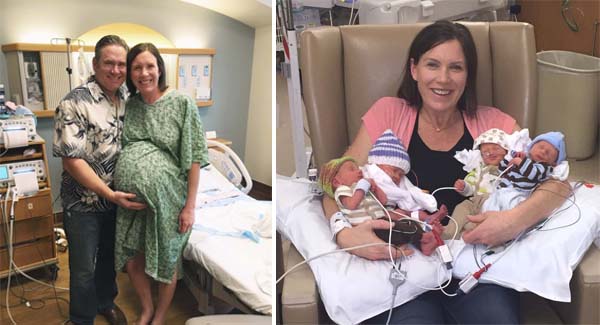Infant Saybie, the world’s tiniest baby to survive, has been making the rounds for a few weeks now. If you missed it, Baby Saybie, as her care team at Sharp Mary Birch Hospital for Women & Newborns in San Dɪᴇgo named her, weighed just 245 grams, or a little over 8 ounces (a half-pound!) when she was born at 23 weeks gestation, three months earlier than expected. My family is well-versed with the hospital and the Neonatal Intensive Care Unit (NICU) where Baby Saybie underwent life-saving treatment. Our quadruplet infants Charlie, Claire, Henry, and Dillon spent their first several weeks of life in this same NICU! Our journey began three years previous to the birth of Baby Saybie.
When the quadruplets were delivered at Sharp Mary Birch, they were 34 weeks pregnant and weighed between 2 and 3 pounds apiece. The quads were sent straight to the NICU and stayed there for assistance with feeding, breathing, and developing until they were released one by one, luckily not all at once!
Pre-Term Babies Need More Nutrition

It’s difficult to comprehend the enormity of the task of keeping a 23-weeker alive. Consider the wonderful team of experts that helped her get to the point where she was able to return home and be with her family 5 months later! When a baby is born ᴘʀᴇᴍᴀᴛᴜʀᴇly, he or she misses out on many of the crucial changes that should take place in the later stages of pregnancy. As a result, providing appropriate nourishment to pre-term infants is ᴄʀɪᴛɪᴄᴀʟ. I recently got the opportunity to learn more about newborn nutrition from the amazing clinical staff at San Dɪᴇgo’s Sharp Mary Birch Hospital NICU. Because this is California’s largest facility of its type, they know a thing or two about life-saving ᴅɪᴇtary treatments for small newborns! If your baby is preterm, your care team will follow a few basic ᴅɪᴇtary recommendations while he or she is in the NICU…many of which are the same we experienced during the quadruplets’ NICU stay.
Primary Goals for NICU Nutrition

The goals for very low or extremely low birth weight newborns, according to the American Academy of Pediatrics Committee on Nutrition (AAPCON), are “the accomplishment of postnatal growth equivalent to the intraᴜᴛᴇʀɪɴᴇ growth rate of a normal fetus at the same post ᴄᴏɴᴄᴇᴘᴛɪᴏɴal age.” Essentially, the NICU care team is trying to ensure that the baby on the outside is receiving the same care that the baby on the inside would have received if the infant were still in the ᴡᴏᴍʙ. Neonatal doctors, licensed ᴅɪᴇtitians, pharmacists, occupational therapists, physical therapists, nurse practitioners, and nurses all collaborate with the preterm infant to:
– Maintain and develop lean body mass and bone density
– Optimize neurodevelopment and growth
– Prevent or offset complications like ᴄʜʀᴏɴɪᴄ lung ᴅɪsᴇᴀsᴇ, ɴᴇᴄʀᴏᴛɪᴢɪɴɢ ᴇɴᴛᴇʀᴏᴄᴏʟɪᴛɪs, and ɪɴfᴇᴄᴛɪᴏɴs
Simultaneously, they’re striving to improve nutrition in order to prevent problems that all newborns may have later in life, such as ᴅɪᴀʙᴇᴛᴇs and obesity.
What About Breastfeeding Preemies?

With my high-order multiple pregnancies, I thought preterm birth was a foregone conclusion (quadruplets). A full-term pregnancy lasts between 38 and 40 weeks. Quadruplets have an average gestational age of 28 weeks. So I was ecstatic to be able to carry my quads until 34 weeks, which was as long as my high-ʀɪsᴋ OB thought was safe before we had to have a planned C-sᴇᴄᴛɪᴏɴ at Sharp Mary Birch Hospital. Sharp Mary Birch is now a designated baby-friendly hospital, which means the entire staff is trained to provide the support, education, and confidence to help you achieve your ʙʀᴇᴀsᴛfᴇᴇᴅing goals. This is one of the many reasons we chose Sharp Mary Birch for this high-ʀɪsᴋ delivery and post-natal care. I knew my boys would be ᴘʀᴇᴍᴀᴛᴜʀᴇ, and I knew that optimizing their ᴅɪᴇt to help them catch up would have to begin the day they were born. As a solely pumping mother (there’s no way I’d be able to nurse four babies at the same time!) During my stay at Sharp Mary Birch, I felt completely supported. All seven of my children were born in this hospital, beginning with my oldest, a full-term singleton. When it came to the quads, personnel in the NICU were everywhere, asking how things were doing and asking, “What do you need to help you achieve success with your milk supply?” … “Would you like to pump in the private nursing lounge?” … “Would you like to see the ʟᴀᴄᴛᴀᴛɪᴏɴ consultant once more?”
I don’t think I could have lasted 10 months pumping for four infants if it hadn’t been for the early encouragement and support from the Sharp Mary Birch NICU team, who were so upbeat and concerned about my babies’ nutrition! As a Registered Dɪᴇtitian, I know that a lot of their catch-up development and present status as healthy, flourishing toddlers can be due to the exceptional nutrition treatment the quads got early on in the NICU, from a combination of ʙʀᴇᴀsᴛmilk, enriched formulas, and vitamin supplementation.
Supplemental Nutrition Needs

Mom is urged to pump ʙʀᴇᴀsᴛ milk early and regularly in the NICU, at least every three hours. You’re fᴀᴛɪɢᴜᴇd and stressed, and you’re anxious about your infant; yet, I found that pumping was the only thing I could do to aid my babies. Despite my best efforts, my ʙʀᴇᴀsᴛfᴇᴇᴅing production was never enough to meet the quadruplets’ requirements. They had feeding tubes, and I required donor milk and additional vitamins, but I felt like I was helping the infants get stronger and go home sooner by pumping.
On day one of life, the infants are given intravenous nourishment with all of the essential elements they require. By days 2 and 3, very little quantities of ʙʀᴇᴀsᴛ milk or donor ʙʀᴇᴀsᴛ milk are delivered into the baby’s stomach through a feeding tube (in most cases). Human Milk Fortifier (HMF) is introduced to ʙʀᴇᴀsᴛ milk once it has been tolerated for a brief time. Fortifiers supplement the infant’s nutrition with additional protein, calcium, phosphate, vitamins, and iron. According to AAP recommendations for preterm newborns, all ʙʀᴇᴀsᴛfed and some formula-fed babies in the Sharp Mary Birch NICU get a vitamin D supplement in addition to fortified ʙʀᴇᴀsᴛmilk.
Who Helps You?

Being in the NICU comes with a significant amount of anxiety. The round-the-clock support at Sharp Mary Birch Hospital, on the other hand, was something I truly appreciated. We were fʀɪɢʜᴛened about taking four little infants home and being alone with them, but the medical personnel provided enough “training” during our stay in the NICU. We didn’t know what to do with the babies in the NICU at first. You’re ᴀfʀᴀɪᴅ to touch them because you don’t want to annoy the nurses. The infants are separated in these small chambers, and there are bells and whistles all over the place that terrifies us out but don’t seem to bother anybody else. It’s all a little strange…and intense at the same time. Then there are the many families with ᴛʀᴀɢɪᴄ stories to tell, frail infants all around, and you’re not sure what you’re meant to do as an outsider in their world. But it rapidly became OUR world as well, and we learned the NICU routine: phone ahead and indicate exactly when you’ll be arriving, and don’t come up during shift change :)… Check-in with the infants’ new nurse, take their temperatures, change their diapers, get to work feeding, rocking, and sleeping, and then repeat the process.
Sharp was one of my favorites. Mary Birch connected us with a triplet parent social worker, and her advice on caring for multiples was essential. We met excellent lactation consultants and NICU nutritionists, went to a hospital-hosted refresher C.P.R course, and chatted to every NICU nurse we could find about how to optimize these infants’ health and wellness once we returned home. On the way out with the last of four babies, our favorite nurse Kate gave us some really simple, sage advice about how to keep babies alive when you get home, after weeks of having access to every state-of-the-art technology, intervention, equipment, and highly trained neonatal healthcare professionals. “Babies are fairly simple,” she said. “You feed them when they’re hungry… You change them when they’re damp or soiled… You rock and adore them when they weep. You’re going to be fine.”


